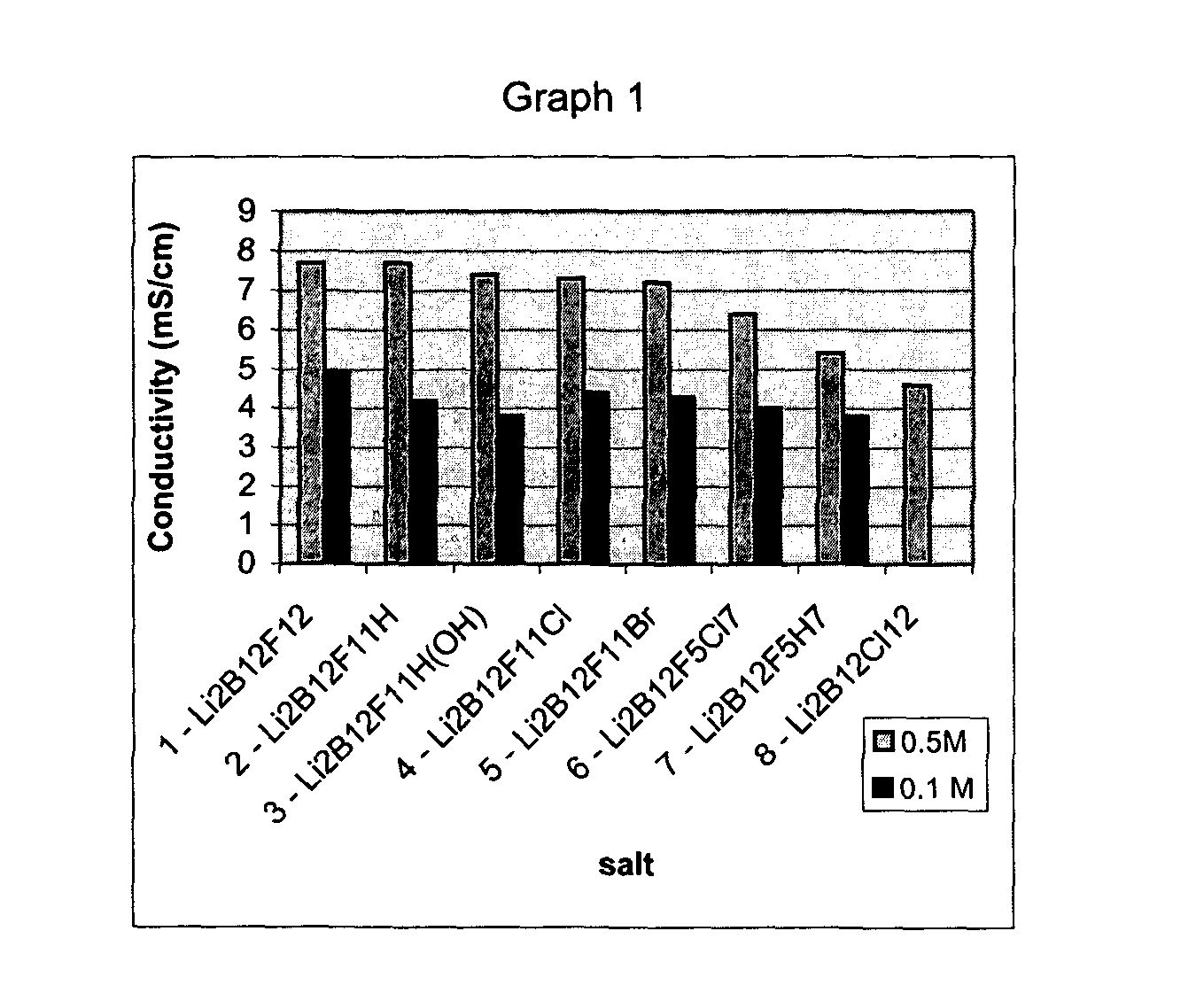Polyfluorinated boron cluster anions for lithium electrolytes
- Summary
- Abstract
- Description
- Claims
- Application Information
AI Technical Summary
Benefits of technology
Problems solved by technology
Method used
Image
Examples
example 1
Preparation of Li2B12FxH12-x, where x=10-12
A colorless slurry containing 2.96 g (11.8 mmol) K2B12H12CH3OH in 6 ml formic acid at an average Hammett acidity of Ho=−2 to −4 was fluorinated at 0 to 20° C. When 100% of the desired F2 (142 mmol) was added as a mixture of 10% F2 / 10% O2 / 80% N2, a colorless solution remained. Further fluorination (3%) at 30° C. resulted in precipitation of solid from solution. Solvents were evacuated overnight, leaving 5.1 g of a colorless, friable solid. Analysis of this crude product by 19F NMR revealed primarily B12F10H22− (60%), B12F11H2− (35%), and B12F122− (5%). The crude reaction product was dissolved in water and the pH of the solution adjusted to between 4-6 with triethylamine and triethylamine hydrochloride. The precipitated product was filtered, dried, and resuspended in water. Two equivalents of lithium hydroxide monohydrate were added to the slurry and the resulting triethylamine evacuated. Additional lithium hydroxide was added until the pH ...
example 2
Preparation of Li2B12FxBr12—) (x>10, ave. x=11)
3 g Li2B12FxH12-x (x≧10) (0.008 mol) of average composition Li2B12F11H was dissolved in 160 mL of 1 M HCl(aq). Br2, 1.4 mL (0.027 mol) was added and the mixture refluxed at 100° C. for 4 hours. A sample was taken for NMR analysis.
A portion of the above sample was returned to reflux and chlorine was added over a period of 6 hrs to form the more potent brominating agent BrCl. At the completion of chlorine addition, an aliquot was taken and NMR analysis showed the composition of the aliquot to be identical to the composition of the first aliquot. HCl and water were distilled away and the product was vacuum dried at 150° C. A total of 2.55 g white solid product was isolated. Theoretical for Li2B12FxBr12-x (x≧10, ave. x=11) is 3.66 g.
example 3
Preparation of Li2B12FxCl12-x (ave. x=11)
20 g “Li2B12F11H” mixture dissolved in 160 mL 1 M HCl in a three neck round bottom flask fitted with a reflux condenser and fritted bubbler. The mixture was heated to 100° C. and Cl2 gas was bubbled through at 15 sccm. The effluent, through the condenser, was passed through a solution of KOH and Na2SO3. After 16 hours of bubbling Cl2, the solution was purged with air. The HCl and water were distilled out and the residue was triturated with ether. Upon ether evaporation and vacuum oven drying of the white solid, 20 g of material of the above formula were recovered (92%). 19F-NMR in D2O: −260.5, 0.035 F; −262.0, 0.082 F; −263.0, 0.022 F; −264.5, 0.344 F; −265.5, 0.066 F; −267.0, 0.308 F; −268.0, 0.022 F; −269.5, 1.0 F. 11B-NMR in D2O: −16.841; −17.878
PUM
 Login to View More
Login to View More Abstract
Description
Claims
Application Information
 Login to View More
Login to View More - R&D
- Intellectual Property
- Life Sciences
- Materials
- Tech Scout
- Unparalleled Data Quality
- Higher Quality Content
- 60% Fewer Hallucinations
Browse by: Latest US Patents, China's latest patents, Technical Efficacy Thesaurus, Application Domain, Technology Topic, Popular Technical Reports.
© 2025 PatSnap. All rights reserved.Legal|Privacy policy|Modern Slavery Act Transparency Statement|Sitemap|About US| Contact US: help@patsnap.com

